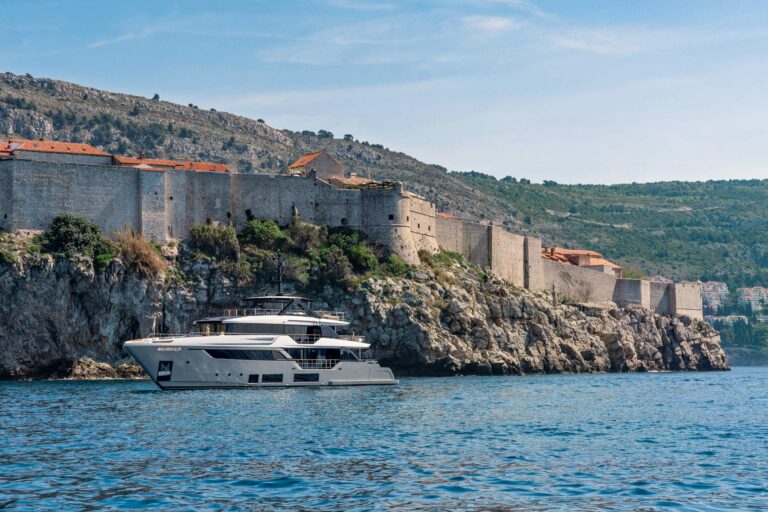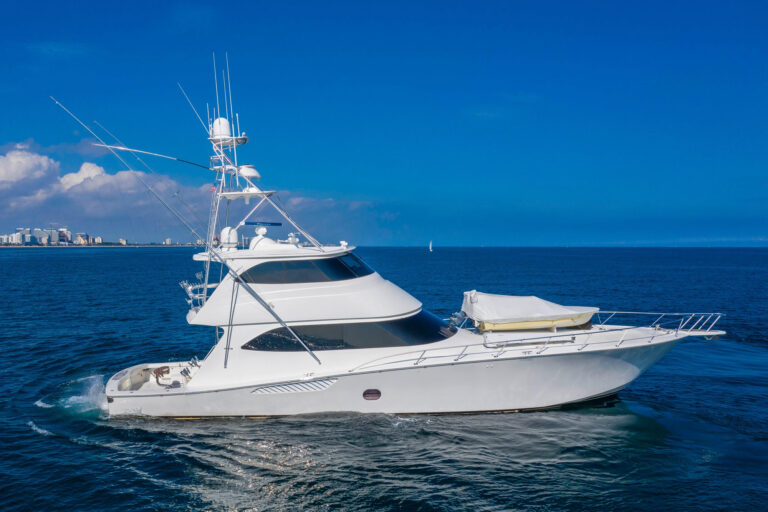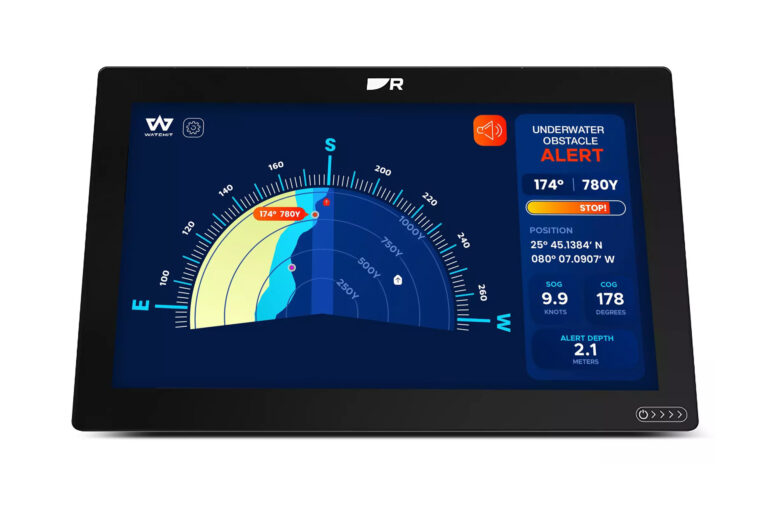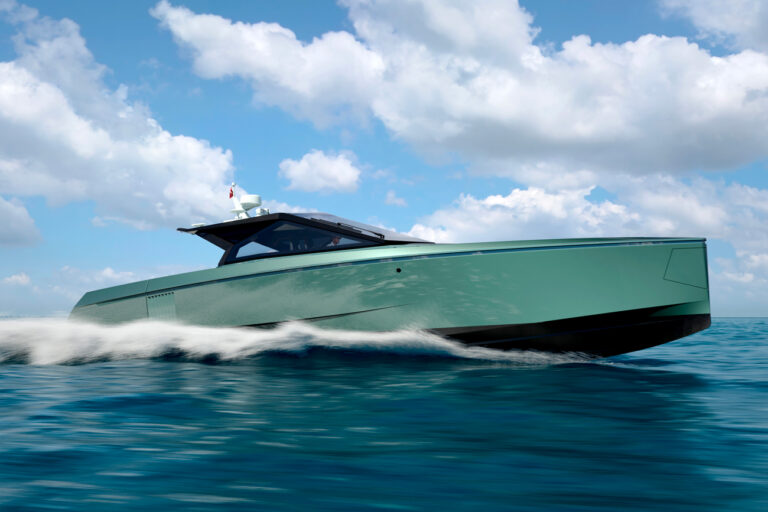We didn’t have to wait for the wind. It had been blowing 15 to 20 since we landed the previous day on Staniel Cay, Exumas, in the Bahamas. Our wish for a shift in wind direction from the north/northwest to north/northeast came true during our first night aboard Sea Hawk, anchored between Big Major’s Spot and Little Major’s Spot north of Staniel Cay and just out of the current and swell of Big Rock Cut. Soon, we’d motor out of the maze of coral heads and set sail for Hawksbill Cay, about 21/2 hours slightly west of north from our anchorage. The wind shift would put us on a beam reach, instead of a beat, so we could hoist the new multipurpose spinnaker.
Sea Hawk, a 78-foot Little Harbor, had waited for our party of four in Staniel Cay, coddling her new owner and his guests for “just one more day. I understood his reluctance to leave as soon as I stepped into the saloon. Sea Hawk, originally owned by Bill Koch of America3 fame, wears her patina with the pride of her aristocratic lineage, as though she were a gentleman’s favorite cashmere jacket. She’s a keel/centerboard ketch drawn by Ted Hood’s design group in the tradition of heavy displacement, slack-bilge cruising yachts meant to play on the world’s oceans, blow high, blow low. Her ketch rig divides the sail area into manageable chunks and keeps it relatively low, which reduces the angle of heel when she’s under a press of sail. Her resistance to heeling and her extraordinarily gentle motion make Sea Hawk ideal for charter guests who aren’t accustomed to sailing.
Our quartet, though, couldn’t wait to get under way. Late autumn weather in the Bahamas may spring a surprise at every sunrise. Temperatures flirting with 90 degrees greeted us when we stepped off the plane yesterday; this morning, our first full day aboard, required a fleece pullover. The front that blew through the area sent a herd of clouds stampeding across the sky, switching the sunlight on and off in an indecipherable code. Through all this, a palate of vivid turquoise, deep blue, brownish green and various shades of crystalline blue shifted on the water. Even under a dull silver-gray overcast, the water’s many hues overloaded my senses.
These colors, forever challenging painters and photographers, are tools for knowledgeable navigators. Capt. Robert Edgar put his temporary engineer on the bow and chef Jim “Mitch Mitchell on the coachroof to look for patches of color that would show rocks, coral heads or sandy shoals. The ideal position would have been on the top set of spreaders, but no one wanted to go up the mast. Although Sea Hawk has a centerboard, she still draws 7 feet with the board retracted.
By 10 a.m., we rounded Fowl Cay, giving it a wide berth to avoid the shallowest water. The wind blew 20 to 22 knots, but the water remained relatively flat on this western side of the Exumas. Calm water is easier to read. A massive coral head appeared off our port bow and another to starboard, an impossibly narrow channel separating them. A hand signal from Travis commanded a hard right. Edgar spun the wheel, and Sea Hawk responded like the thoroughbred she is.
Around the coral head lay a deep channel that was also wide enough to accommodate our beam at the waterline. Come left a few degrees, Travis’ hand commanded. Sandbar ahead. Ease the throttles and check the readout from the sounder. We had about a meter of water below the keel, so everyone started breathing again. The tidal range in the Bahamas is only about 2 feet, so if we buried the keel in the sand, we’d likely stay there until a tug pulled us free. My guess is the skipper knew all along we’d clear the sandbar and was showing off his thorough local knowledge.
At last, roughly four miles west of last night’s anchorage, we broke free of the shadowy maze of shoals, hoisted sail and bore off, sheets started, onto a close reach. Edgar shut down the Yanmar auxiliaries, bidding our cares be gone, as Sea Hawk rolled confidently and gracefully onto her portside waterlines and settled into an 8-knot groove. With all the grace of a Victorian hostess at afternoon tea, Sea Hawk lulled one member of our party into a nap and sent another to lounge in a teak chaise lounge on the windward side of the foredeck.
“Captain Rob, I said, “may I drive for a bit?
Little Harbor Yachts built Sea Hawk in 1984, and she received a refit in 1999. She kept her mechanical steering, though, and all the wonderful tactile sensations such a system transmits to the wheel. She balanced easily and held her course without fussing, as any good cruising boat should.
Boats of high quality have an almost human way of aging, like a grandfather or favorite uncle, calm and wise. I can smell the pipe smoke now. Years of affectionate care darken the hues of the joinerwork. Cast bronze fittings, such as the frames and latches of the portholes, have been buffed so often, they glow from within. Still, tiny specs of green oxidation hide at the depths of the minor imperfections always present in the castings, reminding anyone who cares to look that this is a salty yacht.
Her arrangement plan is salty, too. All of her staterooms are abaft the saloon, but within the area of least motion. In fact, the delightful master all the way aft is likely to have more motion than the two guest staterooms right forward of it. On the other hand, none of this theory matters unless one requests a charter itinerary that includes overnight passages in open water. The business end of Sea Hawk-galley and crew quarters-is forward of the saloon, so the crew can perform most chores without disturbing the charter party.
Although the galley is small by charter yacht standards, Mitchell-formerly part owner and chef of the West Deck restaurant in Newport, Rhode Island-performed his culinary magic to perfection. During our trip, Sea Hawk didn’t have a permanent chef and planned to import one for each charter. We dined at the table in the cockpit at almost every meal. A clever soft dodger system enclosed the cockpit, keeping us comfortable every evening, save the one that ushered in the front. That change sucked the mercury out of the thermometer, so we retreated to the cozy dinette, which permits six adults to extend their elbows without placing them into the neighbor’s plate.
We dropped the hook off the southwestern end of Hawksbill Cay, in time for a late lunch. Scallops of white-sand beach defined the western shore of this island. It’s part of the Exuma Cays Land and Sea Park, an area about 22 miles long and 8 miles wide set aside by the government as a place for wildlife to replenish, nurse and restore their species. Photographer Onne van der Wal and I hiked several miles of coral and beach, and we found a note from Peter Johnstone (son of J Boats’ Bob Johnstone) and his family, who’d visited the island aboard their Gunboat 62 catamaran a few weeks before we did. Small world.
Our third, and last, day aboard Sea Hawk-all courtesy of her owner-we sailed a broad reach under the massive spinnaker, pushing the yacht as though we were leading a regatta. We nearly forgot that in a matter of minutes we’d have to abandon this friendly yacht and her equally friendly crew. Although we loved being in the Exumas, the four of us agreed that Sea Hawk, much more than the area, had made this charter special.
Contact: Jody Lexow Yacht Charters, (800) 662-2628, (401) 849-1112; jl@lexowcharters.com; www.jodylexowyachtcharters.com, or any charter broker. Sea Hawk charters for $21,500 per week, plus expenses, for six guests.








